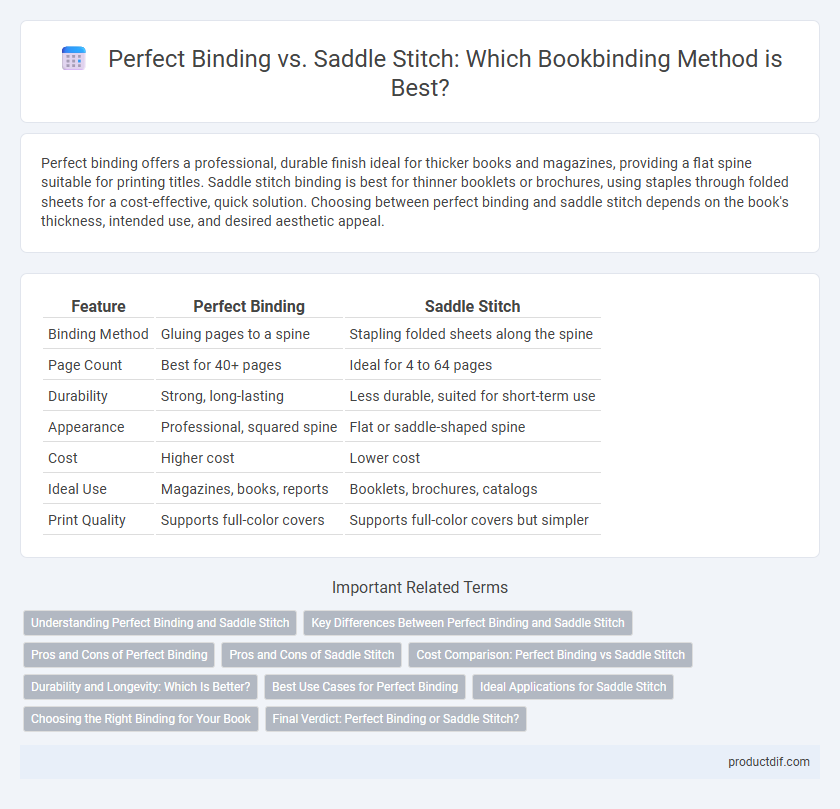Perfect binding offers a professional, durable finish ideal for thicker books and magazines, providing a flat spine suitable for printing titles. Saddle stitch binding is best for thinner booklets or brochures, using staples through folded sheets for a cost-effective, quick solution. Choosing between perfect binding and saddle stitch depends on the book's thickness, intended use, and desired aesthetic appeal.
Table of Comparison
| Feature | Perfect Binding | Saddle Stitch |
|---|---|---|
| Binding Method | Gluing pages to a spine | Stapling folded sheets along the spine |
| Page Count | Best for 40+ pages | Ideal for 4 to 64 pages |
| Durability | Strong, long-lasting | Less durable, suited for short-term use |
| Appearance | Professional, squared spine | Flat or saddle-shaped spine |
| Cost | Higher cost | Lower cost |
| Ideal Use | Magazines, books, reports | Booklets, brochures, catalogs |
| Print Quality | Supports full-color covers | Supports full-color covers but simpler |
Understanding Perfect Binding and Saddle Stitch
Perfect binding involves gluing the pages and cover together at the spine, creating a clean, professional appearance ideal for thicker books such as novels and manuals. Saddle stitch uses folded sheets stapled through the fold line, best suited for thinner booklets, brochures, or magazines with fewer pages. Understanding the differences in durability, cost, and aesthetic appeal helps in selecting the appropriate binding method for specific publishing needs.
Key Differences Between Perfect Binding and Saddle Stitch
Perfect binding uses a strong, flexible adhesive to secure individual pages and a wrap-around cover, providing a professional appearance suited for thicker books with a high page count. Saddle stitch involves folding sheets and stapling them along the spine, making it ideal for thinner publications like booklets and magazines with fewer pages. Key differences include durability, cost-effectiveness, and suitability based on the number of pages and intended use.
Pros and Cons of Perfect Binding
Perfect binding offers a professional, clean appearance suitable for thicker books and allows full-bleed cover artwork but tends to be less durable over time compared to sewn binding methods. It provides a flat spine ideal for displaying titles on shelves, yet the pages may detach with frequent use or improper handling. This binding method is cost-effective for medium to large print runs but can be challenging for thin booklets due to its requirement for a minimum page count.
Pros and Cons of Saddle Stitch
Saddle stitch binding is cost-effective and fast, ideal for booklets and brochures with fewer pages, offering a sleek, flat spine that allows for easy opening. However, it is limited by the number of pages it can securely hold, generally less than 64 pages, and lacks the durability of perfect binding for thicker volumes. This method is best suited for short-run publications with minimal page count but may not provide the professional finish required for high-end books.
Cost Comparison: Perfect Binding vs Saddle Stitch
Perfect binding typically incurs higher production costs due to the use of glue, thicker covers, and complex machinery, making it ideal for longer print runs and thicker books. Saddle stitch, relying on stapled folds, is more cost-effective for short print runs and thinner booklets, with lower material and labor expenses. Businesses often choose saddle stitch for economical small publications, while perfect binding suits premium or higher-page-count projects despite its steeper pricing.
Durability and Longevity: Which Is Better?
Perfect binding offers superior durability and longevity compared to saddle stitch, as its glued spine securely holds more pages and withstands frequent handling. Saddle stitch uses staples that work well for thinner booklets but are prone to wear and page loosening over time. For books requiring extended use and sturdier construction, perfect binding is the optimal choice.
Best Use Cases for Perfect Binding
Perfect binding is ideal for thicker books such as novels, manuals, and catalogs that require a professional, durable finish and a flat spine for easy labeling and stacking. This method supports higher page counts, typically ranging from 40 to 300 pages, enhancing the book's longevity and appearance on retail shelves. Perfect binding is also preferred for full-color photo books and magazines where a polished, high-quality presentation is essential.
Ideal Applications for Saddle Stitch
Saddle stitch binding is ideal for booklets, catalogs, magazines, and smaller publications with up to 64 pages, offering a cost-effective and quick binding solution. This method is best suited for materials that require flexibility and easy opening, such as event programs, brochures, and manuals. Lightweight papers and smaller page counts benefit from saddle stitching due to its simplicity and clean, professional appearance.
Choosing the Right Binding for Your Book
Perfect binding offers a sleek, professional finish ideal for thicker books, such as novels or annual reports, by gluing pages to a square spine that accommodates more pages effortlessly. Saddle stitch, using staples along the folded spine, suits thinner publications like magazines or brochures, providing cost-effective and quick assembly but limited to fewer pages. Selecting the appropriate binding depends on your book's page count, budget, and desired durability to ensure a polished and practical final product.
Final Verdict: Perfect Binding or Saddle Stitch?
Perfect binding offers a professional finish with durable spines, ideal for thicker books like novels or manuals exceeding 40 pages. Saddle stitch is cost-effective for shorter booklets, brochures, or magazines under 40 pages, providing quick turnaround and a flat foldable spine. Choosing between perfect binding and saddle stitch depends primarily on page count and desired longevity.
Perfect Binding vs Saddle Stitch Infographic

 productdif.com
productdif.com